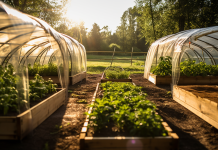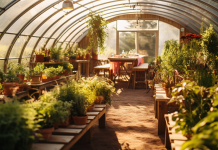Welcome to our article on future plans and expanding your herb garden. Whether you are a seasoned gardener or new to the world of herbs, this guide may help provide you with the necessary steps to assess your space, select the right herbs, and expand your garden.
We will discuss the benefits of both container and in-ground planting methods, as well as provide tips for maintaining and caring for your expanded herb garden.
Cultivate a thriving and bountiful herb garden for those culinary adventures.
Assessing Your Space and Planning for Growth
Assessing the available space and planning for future growth are essential steps in expanding your herb garden. Before you start planting, it is important to evaluate the amount of sunlight your garden receives.
Most herbs require full sun, which means they need at least six hours of direct sunlight per day. Take note of any shady areas and consider planting shade-loving herbs in those spots.
Additionally, maximizing vertical space can greatly increase the capacity of your herb garden. Utilize trellises, hanging baskets, and wall-mounted planters to grow herbs vertically, saving valuable ground space. This not only allows you to grow more herbs but also adds a visual appeal to your garden.
Selecting the Right Herbs for Expansion
When expanding your herb garden, it is important to carefully choose and select the right herbs for your specific needs and preferences. Here are some factors to consider when selecting herbs for expansion:
- Growing conditions: Take into account the specific growing conditions required by different herbs. Some herbs thrive in full sun, while others prefer partial shade. Consider the soil type and moisture levels needed by each herb as well.
- Herb combinations: Think about the combinations of herbs you would like to grow together. Some herbs have complementary flavors and can be used together in cooking, such as basil and tomatoes. Others have beneficial effects when grown together, such as marigolds repelling pests from neighboring herbs.
- Personal preferences: Consider your own preferences when selecting herbs for expansion. Choose herbs that you enjoy using in cooking or ones that have medicinal properties you find useful.
Expanding Your Herb Garden: Containers Vs. In-Ground Planting
Containers provide a versatile and convenient option for expanding your herb garden, while in-ground planting offers a more traditional and permanent approach. When deciding between container gardening and in-ground planting, it is essential to consider factors such as space availability, mobility, and soil preparation.
Container gardening allows you to easily move your herbs around, making it ideal for those with limited space or those who want the flexibility to rearrange their garden. Additionally, container gardening allows for better control over soil quality and drainage, as you can choose the appropriate potting mix for your herbs.
On the other hand, in-ground planting provides a more natural and long-lasting solution. It requires proper soil preparation, including loosening the soil and adding organic matter to enhance drainage and nutrient content. This method also allows for herbs to establish deeper root systems, resulting in healthier and more robust plants.
Consider the following table for a quick comparison between container gardening and in-ground planting:
| Container Gardening | In-Ground Planting |
|---|---|
| Versatile and convenient | Traditional and permanent |
| Ideal for limited spaces | Requires proper soil preparation |
| Easier to control soil quality | Allows for deeper root systems |
| Requires regular watering | Less maintenance once established |
Ultimately, the decision between container gardening and in-ground planting depends on your specific needs, preferences, and available resources. Both methods can be successful in expanding your herb garden, so choose the one that aligns with your gardening goals and abilities.
Maintaining and Caring for an Expanded Herb Garden
To ensure the continued growth and health of your expanded herb garden, proper maintenance and care are essential for cultivating thriving plants. Here are some key practices to follow:
- Regular watering: Provide your herbs with adequate moisture, ensuring they are not overwatered or underwatered.
- Pruning techniques: Trim your herbs regularly to encourage bushier growth and prevent leggy plants. Prune any dead or damaged parts to maintain the overall health of your garden.
- Pest management: Keep an eye out for common pests like aphids and snails. Use organic pest control methods or natural predators to protect your herbs from infestations.
By implementing these maintenance practices, you can ensure that your expanded herb garden flourishes.
Creative Ways to Utilize and Enjoy Your Expanded Herb Garden
Additionally, by incorporating your freshly expanded herb garden into your daily routine, you can infuse your meals, beverages, and even self-care practices with the flavors and benefits of these aromatic plants.
One creative way to make the most of your expanded herb garden is by experimenting with innovative recipes. From using fresh basil in homemade pesto to adding mint leaves to your summer cocktails. Not only will these recipes impress your family and friends, but they will also allow you to fully enjoy the unique flavors of your homegrown herbs.
Another way to utilize your herb garden is by engaging in herb garden crafts. Create beautiful herb-infused candles, potpourri, or even herb-infused oils and salves for self-care. These crafts not only showcase the beauty of your herbs but also provide soothing and aromatic benefits for your well-being.
Key Takeaways
- Planning for next season is often better done from beside the fire
- Assess the amount of sunlight your garden receives and plan accordingly
- Select the right herbs based on their growing conditions and complementary flavors
- Decide between using containers or in-ground planting for expansion, considering factors like space and control over soil quality
- Regularly maintain and care for your expanded herb garden by watering, trimming, and addressing pests
| Herb | Lifespan | Approx Height (cm) | Approx Spread (cm) | Useful Tip | Additional Info | Sunlight |
| Rosemary | Perennial | 90-150 | 60-90 | Needs well-drained soil and full sunlight. | Can be used as a decorative border due to its height. | Full Sun |
| Mint | Perennial | 60-90 | 45-60 | Grows invasively, consider planting in containers or confined spaces. | Keep soil consistently moist. | Partial Shade to Full Sun |
| Basil | Annual | 30-60 | 20-30 | Requires warm temperatures and 6-8 hours of direct sunlight daily. | Regularly pinch off leaves to encourage bushy growth. | Full Sun |
| Chives | Perennial | 30-50 | 20-30 | Easy to grow; keep in a sunny spot and water moderately. | Flowers are edible and can be used as a garnish. | Full Sun to Partial Shade |
| Parsley | Biennial | 30-45 | 20-30 | Prefers rich, moist soil with good drainage. | Harvest leaves regularly to encourage new growth. | Partial Shade |
| Thyme | Perennial | 15-30 | 20-30 | Tolerant of drought and poor soil. | Avoid over-watering, as it prefers slightly dry conditions. | Full Sun |
Conclusion
In conclusion, expanding your herb garden requires careful planning and consideration of various factors such as space, herb selection, planting methods, and maintenance.
By assessing your space, selecting the right herbs, and choosing between containers or in-ground planting, you can successfully expand your herb garden.
Additionally, maintaining and caring for an expanded herb garden is crucial for its long-term success. This includes regular watering, proper fertilization, and regular pruning to promote healthy growth.
Finally, finding creative ways to utilize and enjoy your expanded herb garden can enhance your overall gardening experience. This can include using the herbs in cooking, making homemade herbal remedies, or even creating herbal teas and infused oils.
By following these steps and taking the time to plan and care for your expanded herb garden, you can create a beautiful and productive space that will provide you with fresh herbs for years to come.
Please see our supporting article:
Polytunnel Herbs – Setup and Preparation



